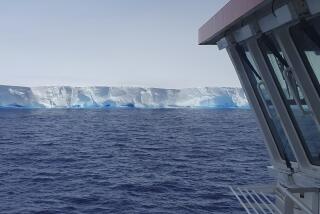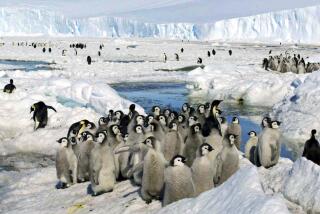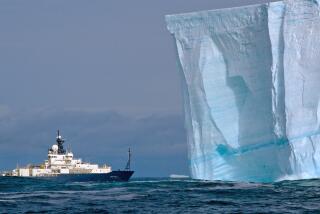Tourism to Antarctica Warming Up
- Share via
ANVERS ISLAND, Antarctica — This icy land at the ends of the earth may top everyone’s list of remote and uninhabitable places, but to the scientists who spend the season working here, it sometimes seems like Grand Central Station.
At the United States’ Palmer Station, for example, science leader Mark Chappell of the University of California, Riverside, came on board our ship, Society Expeditions’ World Discoverer, to talk to passengers about current research projects rather than invite us to visit them ashore.
“Last year we had 18 cruise ship visits in 10 or 11 weeks with 100 to 120 passengers each, so you lost most of a day’s work out of a very short research season,” Chappell said.
Warm Station Welcomes
At the other stations, the welcomes were warm--the Poles at Arctowski greeted us with vodka and sausages, the Brazilians with steaming cups of coffee and the Russians at Bellinghausen with hearty glasnost , insisting that we look at everything whether we wanted to or not.
But there was concern throughout the scientific community about a proposed schedule of seven Antarctic cruises by a 650-passenger ship, the Greek-owned, Argentine-chartered Mediterranean Sky.
Those sailings were later canceled, however, “due to technical problems,” according to Latour in New York, the company that had been marketing the cruises for as little as $682 for 10 days in a six-berth cabin.
How much shipboard tourism is too much for the Antarctic?
This is a question some Antarctic experts feel should come under discussion by signatory nations of the Antarctic Treaty in 1991 when the Scientific Committee on Antarctic Research can propose amendments to the treaty.
Many believe that continued visits by travelers who go to the Antarctic on small expedition ships are beneficial in the long run, since their presence could discourage any government or scientist from careless or destructive behavior.
The penguins and seals are the real pioneers of Antarctica. When the whaling stations were established, the whales followed in the footprints of the penguins, who had long ago selected for their nesting sites accessible places that were sheltered from the worst of the weather and where the snow melted early.
Calls at Same Ports
The scientific stations followed soon after, and today’s expedition ships in the Antarctic still call at all the same places--where there are safe anchorages, penguin nesting colonies and past or present station locations.
Penguins appear to be a fairly resilient species, tolerant of man so long as visitors are careful not to disturb a nesting bird, causing it to break or abandon the egg. (Male and female penguins take turns on the nest.)
A far greater problem is the question of rescue and housing facilities for passengers and crew if a large ship should run aground, experience a fire or get trapped in the moving ice pack.
“I have visions of a huge ship running aground and spilling oil on everything,” Chappell said.
“One hundred passengers, that’s the best maximum for an Antarctic ship,” Special Expeditions Captain Hasse Nilsson, a veteran of the icy southern seas, says.
At present, it would appear that anyone who wants to can send a passenger ship to the Antarctic. Whether they can get ice insurance, however, is another story.
Two Passenger Ships
There are only two ships now in Antarctic passenger service with shallow drafts and ice-hardened hulls--the World Discoverer and the Society Explorer, both belonging to Seattle-based Society Expeditions. A third small ship, the Illiria, is currently in her second season of Antarctic cruising, under charter by Lindblad Travel.
Several expedition companies are considering plans to build new vessels qualified for Antarctic cruising.
Why is there so much interest in going to this remote and inhospitable continent?
While Caribbean sun-worshipers might recoil in horror at the chilling winds and rough seas, plus the landings in inflatable rubber zodiacs that require layers of waterproof clothing, Antarctic cruises, at $350 a day probably the most expensive of all expedition sailings, sell out quickly.
To be assured of a place, passengers often book six months to a year in advance for the late November to February season.
An Antarctic cruise is more than close-up looks at thousands of penguins and hundreds of seals, or the surge of accomplishment at walking where so few humans have been before.
It is the most pristinely beautiful place on earth, with black volcanic sand and steaming hot springs surrounded by snow-capped mountains and meringue-like glaciers stretching down to the sea.
Shapes and Shadings
Wind-sculpted icebergs 10 stories tall take on different shapes and shadings, from aquamarine to ice-blue marble, as the ship’s inflatable landing craft takes passengers around it.
A dozen penguins out for a ride on an ice floe drift by in a twitter of indecisiveness about whether they want to go swimming, while the dark liquid eyes of an elephant seal regard its human visitors without fear and with only the faintest trace of curiosity.
In such a fragile and extraordinary place, man too must tread gently and in small numbers. Otherwise, restraints might become necessary, either self-imposed within the travel industry or by the conference of signatory nations.
For more information on Antarctic sailings, call Society Expeditions at (800) 426-7794 or Lindblad Travel at (800) 243-5657.
More to Read
Sign up for The Wild
We’ll help you find the best places to hike, bike and run, as well as the perfect silent spots for meditation and yoga.
You may occasionally receive promotional content from the Los Angeles Times.






